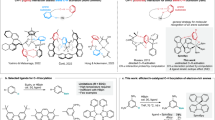Abstract
WE earlier described1 two isomeric platinous complexes of the general formula (PPrn3)2Pt2(SCN)2Cl2, which we designated α (melting point, 144–152° C.) and β (melting point, 173–174.5° C.). These were shown to have trans-symmetrical structures of type (I), where A, B, C and D represent the thiocyanato- and chloro-groups.
This is a preview of subscription content, access via your institution
Access options
Subscribe to this journal
Receive 51 print issues and online access
$199.00 per year
only $3.90 per issue
Buy this article
- Purchase on Springer Link
- Instant access to full article PDF
Prices may be subject to local taxes which are calculated during checkout
Similar content being viewed by others
References
Chatt, J., and Hart, F. A., Nature, 169, 673 (1952).
Chatt, J., and Duncanson, L. A., Nature, 178, 997 (1956).
Lindqvist, I., Acta Cryst., 10, 29 (1957).
Author information
Authors and Affiliations
Rights and permissions
About this article
Cite this article
CHATT, J., DUNCANSON, L., HART, F. et al. Isomerism among Binuclear Thiocyanatobridged Complexes. Nature 181, 43–44 (1958). https://doi.org/10.1038/181043a0
Issue Date:
DOI: https://doi.org/10.1038/181043a0
This article is cited by
-
The effect of metal salts on polyurethane foam: antioxidation and reduction of VOCs emissions
Journal of Polymer Research (2021)
-
Infrared absorption spectra of complexes of thorium (IV) with NCS groups
Bulletin of the Academy of Sciences, USSR Division of Chemical Science (1964)
-
Infrared absorption spectra of thiocyanate complexes of hafnium (IV)
Bulletin of the Academy of Sciences, USSR Division of Chemical Science (1963)
-
Crystal chemistry of complex platinum compounds. Part 2. Bivalent platinum compounds
Journal of Structural Chemistry (1963)
-
Infrared absorption spectra of zirconium rhodanide complexes
Bulletin of the Academy of Sciences of the USSR Division of Chemical Science (1962)
Comments
By submitting a comment you agree to abide by our Terms and Community Guidelines. If you find something abusive or that does not comply with our terms or guidelines please flag it as inappropriate.



